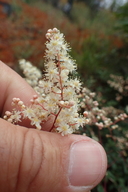Taxon Details
Holodiscus discolor var. cedrorum
Cedars oceanspray
View Report Copy Link Calflora eFlora CCH CalPhotos iNaturalist
Taxon Summary:
Holodiscus discolor var. cedrorum, commonly known as Cedars oceanspray, is a perennial deciduous shrub in the Rosaceae that is found only in California. It occurs within Chaparral (sometimes), and Closed-cone coniferous forest, growing at elevations from 170 to 540 meters. Holodiscus discolor var. cedrorum is ranked 1B.3, Plants Rare, Threatened or Endangered in California and Elsewhere; Not very threatened in California.|
Scientific Name: Holodiscus discolor (Pursh) Maxim. var. cedrorum (Raiche & Reveal) D. Potter & Raiche |
||
|
Common Name: Cedars oceanspray |
||
| Family: | Rosaceae | |
| Element Code: | PDROS0V041 | |
| USDA Plants Symbol: | ||
|
Synonyms/Other Names: |
||
| Name Status: |
JEF, FNA, POWO, IPNI, Tropicos |
|
| CA Rare Plant Rank: | 1B.3 |
| Fed List: | None |
| State List: | None |
| Global Rank: | G5T1 |
|
State Rank: |
S1 |
| Other Status: | BLM_S |
|
CRPR Changes: added to 1B.3 on 2024-04-11 |
|
| Add Date: | 2024-04-11 |
| Date Edited: | 2025-10-29 |
| Lifeform: perennial deciduous shrub | ||||||||||||||
Blooming Period: (Apr)May-Jun(Jul)
|
||||||||||||||
|
Elevation:
170 - 540 meters 560 - 1770 feet |
||||||||||||||
General Habitats:
|
||||||||||||||
| Microhabitat Details: Usually on peridotite. Locally common on lower canyon slopes in relatively mesic, old-growth Hesperocyparis sargentii woodland where it may be encountered even in dense shade. Sometimes found in chaparral, predominantly on north-facing slopes. | ||||||||||||||
Microhabitat:
|
||||||||||||||
| Threat List Total: | 0 | |
| Total EOs | % of EOs | |
| EOs with Threat Listed: | 0 | % |
| THREAT LIST: | ||
|---|---|---|
|
|
||
| Total Occurrences: | 9 | ||||
| Element Occurrence Ranks: | |||||
|---|---|---|---|---|---|
| A | B | C | D | X | U |
| 0 | 0 | 0 | 0 | 0 | 9 |
| Occurrence Status: | |||||
|---|---|---|---|---|---|
| Historical >20 Years | 2 | ||||
| Recent <=20 Years | 7 | ||||
| Presence: | |||||
|---|---|---|---|---|---|
| Presumed Extant | 9 | ||||
| Possibly Extirpated | 0 | ||||
| Presumed Extirpated | 0 | ||||
| California Endemic: | |||||||||||||
| California Island: | |||||||||||||
|
States: Name (Code) California (CA) |
|||||||||||||
|
California Counties and Islands: Name (Code) Sonoma (SON) |
|||||||||||||
|
Quads: Name (Quad Code) Cazadero (3812351), Fort Ross (3812352), Tombs Creek (3812362) |
|||||||||||||
Notes:
|
|||||||||||||
 Presumed Extant
Presumed Extant
Click on quad for name. Hold Shift Key to use mouse scroll wheel

